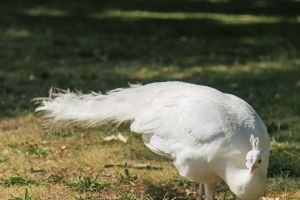The Eurasian lynx, commonly referred to directly as the lynx, is a medium-sized feline, usually found in forests.
They have a wide distribution, extending from Western Europe to Central Asia.
The lynx has a stout body with long limbs and the front and outside of the limbs are spotted.
The tail is extremely short and thick, with a bluntly rounded tip, and the tail end is generally pure black or brown.
The lynx ears are wide, with black, towering tufts of hairs at the tips, 4-5 cm long, interspersed with a few white hairs.
The tufts serve to collect sound waves.
The back of the lynx has the thickest fur and is dotted with dark spots or small stripes, either dark or light.
These spots facilitate its concealment and foraging.
The coat colour on the back is highly variable, with creamy grey, brownish brown, earthy brown, grey grass, yellowish brown and light greyish brown.
The chest and belly are uniformly dirty white or creamy white.
Traditionally, we think of solitary feline males as being free from any responsibility in the process of rearing their young.
When leaving after the female becomes pregnant and then going off to find other females in heat in their territory.
But times are moving on, science is advancing and some traditional perceptions are being refreshed.
For example, we used to think that all felines except lions lived alone.
But today we find that this is not the case, take the Eurasian lynx, they are not alone.
After long studies it has been found that lynx cub survival rates are high, even up to 80%.
In contrast to the forest wolves in the same region, where cub mortality rates reach 60-90%.
The reason behind this seems to be quite related to the role of the male lynx, adult males, who also take on a certain amount of responsibility throughout the process of rearing their young.
They are cared for and protected by the males.
And lynx cubs have a high survival rate despite threats from wolves, red foxes, raccoons, dog badgers.
Like most felines, the lynx is well versed in the art of stealthy stalking.
The fur blends so perfectly into the dappled background of rocks, foliage and shadows that in the blink of an eye it disappears from view as if in a puff of smoke.
You have to carefully distinguish each branch and materialise the big cat's silhouette against the abstract background of woodland, rocks and hills.
Eurasian lynx prefer rugged mountain habitats, which offer plenty of opportunities for hiding and stalking.
And in winter, they tend to descend the mountains to avoid the deep snow.
Despite having evolved the ability to adapt to moving through snow, lynx hate thick snow.
Like most felines, the lynx is well versed in the art of stealthy stalking.
The fur blends so perfectly into the dappled background of rocks, foliage and shadows that in the blink of an eye it disappears from view as if in a puff of smoke.
You have to carefully distinguish each branch and materialise the big cat's silhouette against the abstract background of woodland, rocks and hills.
Eurasian lynx prefer rugged mountain habitats, which offer plenty of opportunities for hiding and stalking.
And in winter, they tend to descend the mountains to avoid the deep snow.
Despite having evolved the ability to adapt to moving through snow, lynx hate thick snow.


